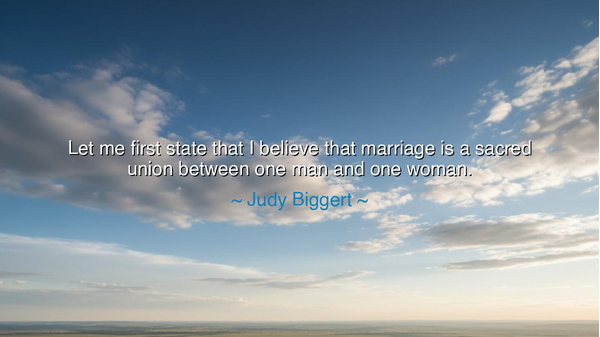
Let me first state that I believe that marriage is a sacred union
Let me first state that I believe that marriage is a sacred union between one man and one woman.






In the ancient cadence of conviction and belief, the words of Judy Biggert ring with solemn certainty: “Let me first state that I believe that marriage is a sacred union between one man and one woman.” These words are not cast in the fire of debate but spoken from the quiet hearth of faith. They reflect a vision of marriage not merely as a social bond, but as a sacred union, a covenant woven by divine threads—an institution older than kings, older than nations, older even than written law. In them lies the echo of centuries of tradition, where man and woman came together not only to share life, but to bind their spirits in the service of love, family, and creation itself.
In speaking these words, Biggert did not seek to reshape eternity, but to honor what she saw as a foundation laid by time and faith. For countless generations, marriage was viewed as the cornerstone of civilization—the meeting of opposites to create harmony, the balance of strength and compassion, reason and intuition, body and soul. Her belief, like that of many before her, springs from this ancient river of thought: that marriage is not only a human contract, but a divine covenant. To her, this union between one man and one woman mirrors the eternal dance of the heavens—the sun and the earth, the day and the night—each distinct, yet incomplete without the other.
Throughout history, humanity has held this union as something holy. In the old temples of Greece, the god Hymenaios was invoked to bless the joining of man and woman, and in the sacred texts of many faiths, marriage is described as a reflection of divine order. Consider the tale of Odysseus and Penelope, whose love endured the trials of war and distance. Though besieged by suitors and separated by fate, their bond held fast, proving that sacred union is not built upon convenience or fleeting passion, but upon fidelity, endurance, and shared purpose. Their story endures as a parable of commitment, echoing the ancient belief that the true power of marriage lies not in its form, but in its faithfulness.
Yet, even as time moves forward, the world around these ancient truths continues to change. Humanity grows, learns, questions, and seeks new understandings of love and union. Some see Biggert’s words as a declaration of constancy in a time of transformation; others see them as a reflection of an older age. But whatever one’s belief, her statement calls us to reflect deeply on what makes any union sacred. Is it its structure—or its spirit? Is it the form, or the fidelity? The ancients would tell us that the sacred resides not in law or title, but in devotion, in the courage to love selflessly, to honor another above oneself.
For even those who differ in belief must recognize the deeper essence that Biggert’s words touch—the yearning for sacredness in human connection. Whether one defines marriage as between a man and a woman, or between any two souls bound in truth, the lesson remains: love demands reverence. It is not to be treated as a contract of convenience or a fleeting emotion, but as a covenant—a promise that shapes the moral spine of humanity. The sacred union she describes, when seen through this lens, transcends mere politics; it speaks to the universal human need to anchor love in something eternal.
Thus, let this reflection serve as a teaching to the generations who come after. To hold something sacred is to treat it with awe and responsibility. Whether you share Biggert’s belief or walk a different path, let your unions—romantic, familial, or communal—be guided by honor, loyalty, and respect. Let your love not be shallow as the shifting tides, but deep as the roots of the mountains. When you promise yourself to another, do so not with mere words, but with the steadfastness of the ancients who knew that love, once consecrated, is the mightiest bond of all.
And so, the wisdom of this saying endures: marriage is a sacred union, not because it belongs to one definition, but because it calls humanity to its highest virtue—commitment. Love, in its truest form, is not a momentary flame, but an everlasting fire that must be tended, honored, and protected. Walk, therefore, with reverence in your unions, and remember: whether by tradition or new understanding, it is not the form of love that sanctifies it, but the faithfulness of the hearts within it.






AAdministratorAdministrator
Welcome, honored guests. Please leave a comment, we will respond soon